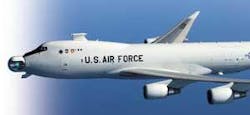By John McHale
EDWARDS AIR FORCE BASE, Calif. - The Boeing-led Airborne Laser (ABL) team finished a series of tests of its high-energy laser at the Systems Integration Lab at Edwards Air Force Base, Calif.
During the tests, experts demonstrated lasing duration and power at levels suitable to destroy several classes of ballistic missiles, Boeing officials say.
“On 6 December, the Airborne Laser’s megawatt-class laser fired long enough and with sufficient power to prove it is technically capable of destroying boost-phase ballistic missiles,” says Col. John Daniels, director of the Airborne Laser System Program Office at Kirtland Air force Base, N.M.
Since the tests began in November 2004, the chemical oxygen iodine laser (COIL) fired more than 70 times, beginning with a burst of a fraction of a second and increasing until the firing on Dec. 6 at a level believed to be strong enough to destroy a ballistic missile during its boost phase, or within the first few minutes after it is launched, Daniels says.
This was the second of two significant knowledge points planned for 2005. The ABL COIL, from Northrop Grumman Space systems in Redondo Beach, Calif., fits on a Boeing 747-400 aircraft.
The test “clears the way for the next step-the disassembly and refurbishment of the COIL modules in preparation for installing them in the ABL aircraft once it returns to Edwards AFB, Calif., from the Boeing Modification Facility in Wichita, Kan., in early 2007,” Daniels says.
Lasing tests included more than 70 separate lasing events. The laser has been operated at simulated altitude, and achieved steady-state operations under full optical control.
Last summer, the ABL team tested the system’s passive mission payload at Edwards Air Force Base. During those tests, the team demonstrated the stability and alignment of the two beam-control and fire-control optical benches with the turret. That test also demonstrated the system’s pointing- and vibration-control functions, as well as its ability to acquire targets, Boeing officials say.
The program now proceeds to integrated systems testing. The ABL YAL-1A aircraft has moved to Boeing’s Wichita, Kan., facility for final modifications necessary to install the high-energy laser modules and to begin low-power system integration and active ground and flight testing.
“The next key step in the program is ground/flight testing of the two illuminator lasers-the TILL and the BILL-in the ABL aircraft,” Daniels says. “They are used to track hostile ballistic missiles and measure the amount of atmospheric distortion between the aircraft and the target in preparation for firing the COIL, which will destroy the target. These lasers are soon to be installed in the aircraft at Boeing’s Wichita modification facility.”
BILL is short for beacon illuminator laser, and TILL stands for tracking illuminator laser.
Some challenges remain. “In the short run, [the ABL team needs to] make sure the BILL and the TILL can operate successfully in an airborne environment and in the long run, test an airborne COIL and meld its operation with that of the TILL and BILL,” Daniels says.
During active testing, the kilowatt-class illuminator lasers will be integrated and tested to demonstrate target acquisition, fine tracking, pointing, and atmospheric compensation. Upon completion of active testing, the YAL-1 will return to Edwards Air Force Base for installation of the high-energy laser, which will be removed from the System Integration Laboratory. This will be followed by extensive weapon systems testing on the aircraft-both ground and flight.
“Proving the capability of this laser to operate at lethal levels of power and duration moves the system a major step closer to becoming a vital component of the nation’s boost-phase defense against a ballistic missile threat,” says Pat Shanahan, vice president and general manager of Boeing Missile Defense Systems.
“ABL expects to shoot down its first ballistic missile in late 2008,” Daniels says. “This will be only the first step in demonstrating its capabilities. Commitment dates for fielding and operating the system have not yet been determined and will be based on our success over the next three years with our prototype aircraft.”
Boeing provides the modified aircraft and battle management segments and is the weapon system integrator. ABL partners include Northrop Grumman, which provides the laser segment, as well as the Beacon Illuminator. Lockheed Martin is the third partner and provides the beam- control/fire-control segment, which contains state-of-the-art optics for control of the solid-state illuminators for tracking and atmospheric compensation as well as the high-energy laser. Lockheed also provides ABL’s flight-turret assembly.




